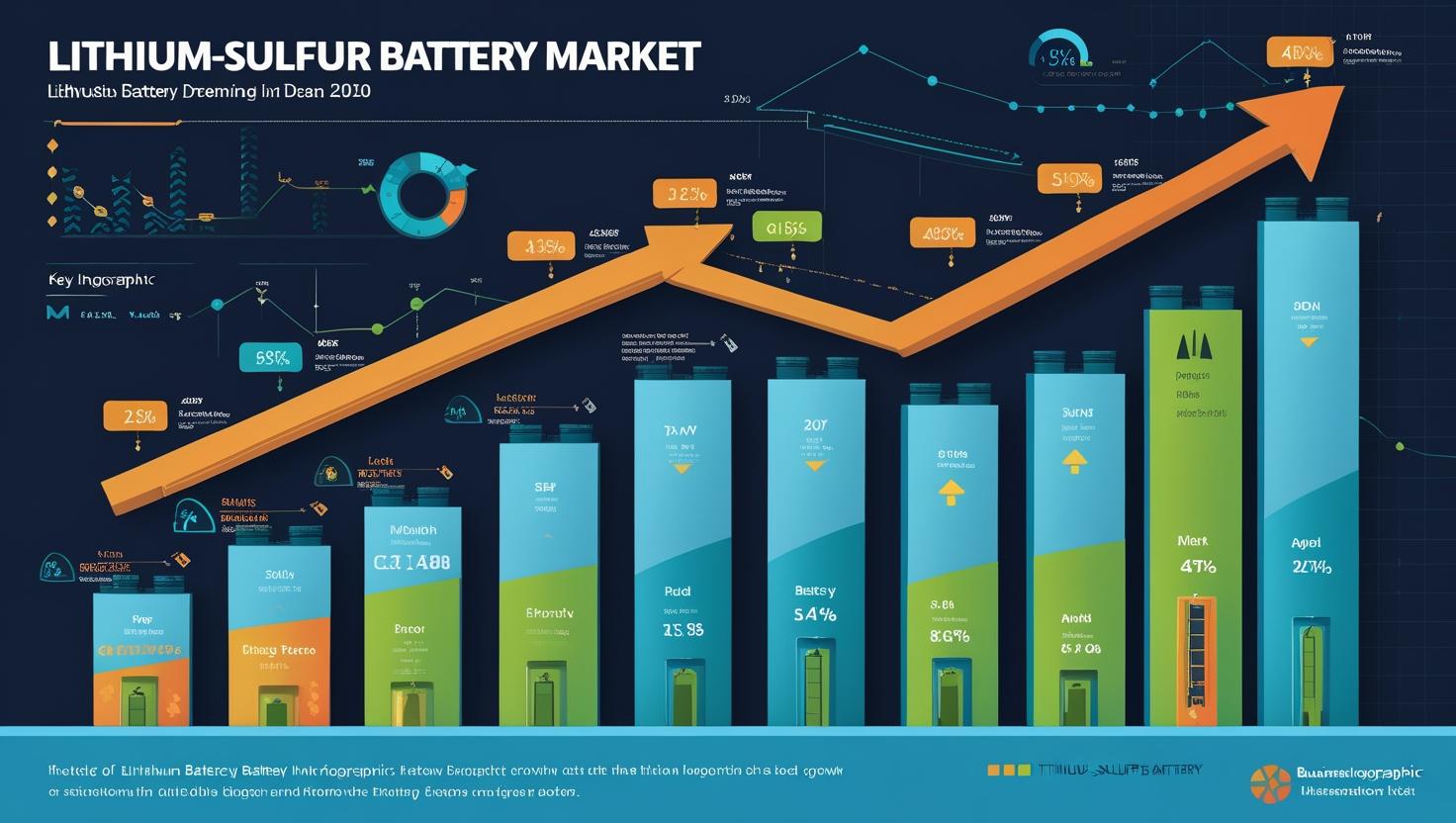The global Lithium–Sulfur (Li–S) Battery Market is gaining significant traction as industries seek energy storage solutions that offer higher performance, lighter weight, and improved sustainability over conventional lithium-ion technology. Known for their exceptional energy density, cost-effectiveness, and eco-friendly materials, Li–S batteries are emerging as a transformative force in sectors like aerospace, automotive, and renewable energy.
By Component: Cathode, Anode, and Electrolyte Innovations
At the core of Li–S battery innovation are its key components — the cathode, anode, and electrolyte — each contributing to performance and durability.
The cathode, typically made of sulfur, provides a high theoretical energy capacity, making Li–S batteries up to five times more energy-dense than traditional lithium-ion alternatives. However, challenges such as sulfur’s poor conductivity and polysulfide shuttle effects are being addressed through nanostructured cathode materials and composite designs.
The anode, often made of lithium metal, offers ultra-high specific capacity but requires protective interfaces to prevent dendrite formation and improve cycling stability.
Meanwhile, electrolyte development—whether liquid, semi-solid, or solid-state—remains central to optimizing safety, efficiency, and long-term performance. Innovations in polymer-based and sulfide electrolytes are extending battery life and reducing degradation under high load conditions.
Download PDF Brochure @ https://www.marketsandmarkets.com/pdfdownloadNew.asp?id=231442524

By Type: Liquid, Semi-Solid, and Solid-State Li–S Batteries
Li–S batteries can be categorized into liquid, semi-solid, and solid-state configurations, each designed to balance performance, manufacturability, and application needs.
Liquid Li–S batteries, while currently the most commercially available, face challenges related to the dissolution of lithium polysulfides, which affects cycle life.
Semi-solid designs incorporate gel or hybrid electrolytes that enhance ion transport while mitigating leakage and safety issues.
The solid-state Li–S battery represents the next frontier — offering improved safety, higher stability, and superior energy density, making it an ideal candidate for electric vehicles (EVs) and aerospace applications.
By Capacity: Expanding the Power Spectrum
Li–S batteries are classified by capacity ranges — below 500 mAh, 501 to 1,000 mAh, and above 1,000 mAh — depending on their use case and cell architecture.
Low-capacity cells (<500 mAh) are typically used in wearable electronics, sensors, and portable devices, where compactness and lightweight design are essential.
Mid-range capacities (501–1,000 mAh) are gaining adoption in drones, robotics, and small-scale mobility solutions.
High-capacity Li–S batteries (>1,000 mAh) are at the forefront of automotive and aerospace applications, where extended range, reduced weight, and high energy efficiency are paramount.
By Application: Transforming Aerospace and Automotive Sectors
The aerospace industry is one of the earliest adopters of Li–S technology, leveraging its high specific energy and lightweight design for satellites, drones, and electric aircraft. Li–S batteries reduce total payload weight while delivering longer flight times and mission endurance.
In the automotive sector, Li–S batteries are being explored as the next-generation power source for electric vehicles (EVs). With the potential to deliver more than twice the energy density of lithium-ion batteries, they can extend EV range significantly while lowering manufacturing costs due to sulfur’s abundance and environmental compatibility.
As sustainability becomes central to innovation, Li–S batteries are expected to play a key role in the global transition toward zero-emission transportation.
Market Trends and Future Outlook
The Lithium–Sulfur Battery Market is poised for strong growth, driven by the increasing demand for lightweight, high-performance energy storage systems and ongoing R&D investments by battery manufacturers and research institutions. Technological advancements—such as AI-driven materials design, nanostructured electrodes, and solid-state integration—are addressing the traditional limitations of Li–S chemistry, paving the way for commercial scalability.
Government initiatives supporting clean energy, electrification of transport, and advanced battery R&D are further accelerating adoption. Over the next decade, as solid-state Li–S batteries move from prototype to production, they are expected to challenge lithium-ion dominance and redefine energy storage standards.
Conclusion: The Future of Energy Storage is Lighter, Stronger, and Smarter
The Lithium–Sulfur Battery Market represents a major leap forward in the evolution of battery technology. Combining high energy density, cost efficiency, and environmental advantages, Li–S batteries are set to power the next generation of electric vehicles, aerospace innovations, and sustainable energy systems. As research breakthroughs continue, Li–S batteries stand ready to reshape the global energy storage landscape — one charge at a time.
Lithium–Sulfur Battery Market – Frequently Asked Questions (FAQ)
1. What are Lithium–Sulfur (Li–S) batteries?
Li–S batteries are advanced energy storage devices that use lithium as the anode and sulfur as the cathode, offering higher energy density and lighter weight compared to conventional lithium-ion batteries. They are considered ideal for electric vehicles, aerospace, and other high-performance applications.
2. What are the key components of a Li–S battery?
The primary components include the cathode (sulfur-based), anode (lithium metal), and electrolyte (liquid, semi-solid, or solid-state). Each component affects energy density, cycle life, and overall battery safety.
3. What types of Li–S batteries exist?
Li–S batteries can be liquid, semi-solid, or solid-state. Solid-state Li–S batteries are emerging as the most promising due to improved safety, stability, and energy density.
4. What are the typical capacities of Li–S batteries?
Capacities range from below 500 mAh (for small devices and sensors), 501–1,000 mAh (for drones and robotics), to above 1,000 mAh (for automotive and aerospace applications requiring long-range and high energy).
5. What are the main applications of Li–S batteries?
Li–S batteries are used in aerospace (satellites, drones, electric aircraft), automotive (electric vehicles, hybrid cars), and emerging energy storage solutions where high energy density and lightweight design are critical.
